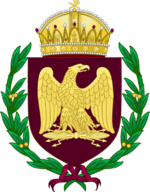Claudian dynasty
This article is incomplete because it is pending further input from participants, or it is a work-in-progress by one author. Please comment on this article's talk page to share your input, comments and questions. Note: To contribute to this article, you may need to seek help from the author(s) of this page. |
| Claudian dynasty | |
|---|---|
 | |
| Country | |
| Founded | 560 BC 577 (as ruling dynasty) |
| Founder | Constantine V Claudius |
| Current head | Jacobus VI Claudius |
| Titles | |
| Style(s) | "His/Her Imperial Majesty" "His/Her Imperial Highness" |
| Estate(s) | Palatium Aurea (official seat) Palatium Supranio (historical seat) Palatium Purpura Casa Claudio |
| Cadet branches | |
The House of Claudius is an Belisarian imperial and royal dynasty of Latin origin. The modern Claudii trace their ancestry to gens Claudia, which first surfaced in the 6nd century BCE according to ancient republican records. The family was an ancient patrician and senatorial family family. The family first rose to prominence in the early Imperial era as Masters of the Aventine, a district of ancient Castellum. Aurelius Claudius Sabinus Theodosius was the first member of the dynasty to marry into the Imperial line of the Iovinian dynasty. His son Constantine Claudius launching a successful war for the throne in 577.
The Claudian emperors continued to rule over the waning Latin Empire until the Crisis of the 11th Century, which resulted in the dynasty's loss in the imperial crown. The dynasty remained in Adrianople ruling as petty rulers, until the 15th century eventually holding the title as Duke of Adrianople. The Claudian dynasty regained the Latin throne in the 1993 with the ascension of Jacobus VI Claudius as junior emperor. His son Constantine XX Claudius, is the current Latin Emperor and head of the House of Claudius.
History
The nomen Claudius, originally Clausus, is originally derived from the word claudus, which roughly translates to "lame". Gaius Claudius is the first Claudii attested to be a Senator of Alba in 560 BCE, with a branch of Claudii earned membership in the Castellum Senate around 300 BC. The first Claduia is said to be Gaius Claudius, who was believed to be of Sabine origin. Gaius Claudius rose to prominence as a general in the 2nd Alban-Sabine War, becoming a Senator of Alba in 560 BC. A branch of the Claudii earned membership in the Castellum Senate around 300 BC.
Members of the family continued to hold key offices of state throughout early periods of Latin history, from the union of Alba and Castellum to the start of the Empire when Appius Claudius Sabinus was made Master of Ianiculum in 195 BCE. In 330, Theodosius Claudius married Maria Iovina the Younger, sister of Alban IV Iovianus. In 577, their son, Constantine Claudius was proclaimed emperor by his legions, which resulted in a civil war and the split of Latin territory in the west and the east, the latter of which would become Perateia. The descendants of Constantine V Claudius ruled Latium until 1047, surviving the chaos and upheaval of the 6th century, and loss of most territory beyond modern day Latium, northern Scipia and parts of southern Audonia. The Crisis of the 11th Century resulted in the dynasty's loss of the imperial throne to the Ostian dynasty of Theodosius V Ostia – the illegitimate son of Constantine XVI Claudius.
Peter of Adrianople continued the former imperial line, with his descendants ruling Adrianople and the surrounding area from the 11th to 15th centuries. In 1428, Constantine IV of Adrianople became the last independent ruler of Adrianople and was granted the title Duke of Adrianople after swearing fealty to Theodosius IX Aemilius. The dynasty served as a prominent Latin noble family thereafter, often earning the consulship. A branch of the family inherited the crown of Garza in 1828, reigning until 1944. Another branch of the family inherited the crown of Sydalon in 1856, which is held until 1944. Dynast Jacobus Claudius, Duke of Adrianople became the longest-serving Praeses Senatus and Master of Offices. The Claudian dynasty became the Imperial house of Latium in 1997 with the elevation of Jacobus VI Claudius to co-Emperor in 1993, reigning alongside his mother Diana I Anicia until 2000.